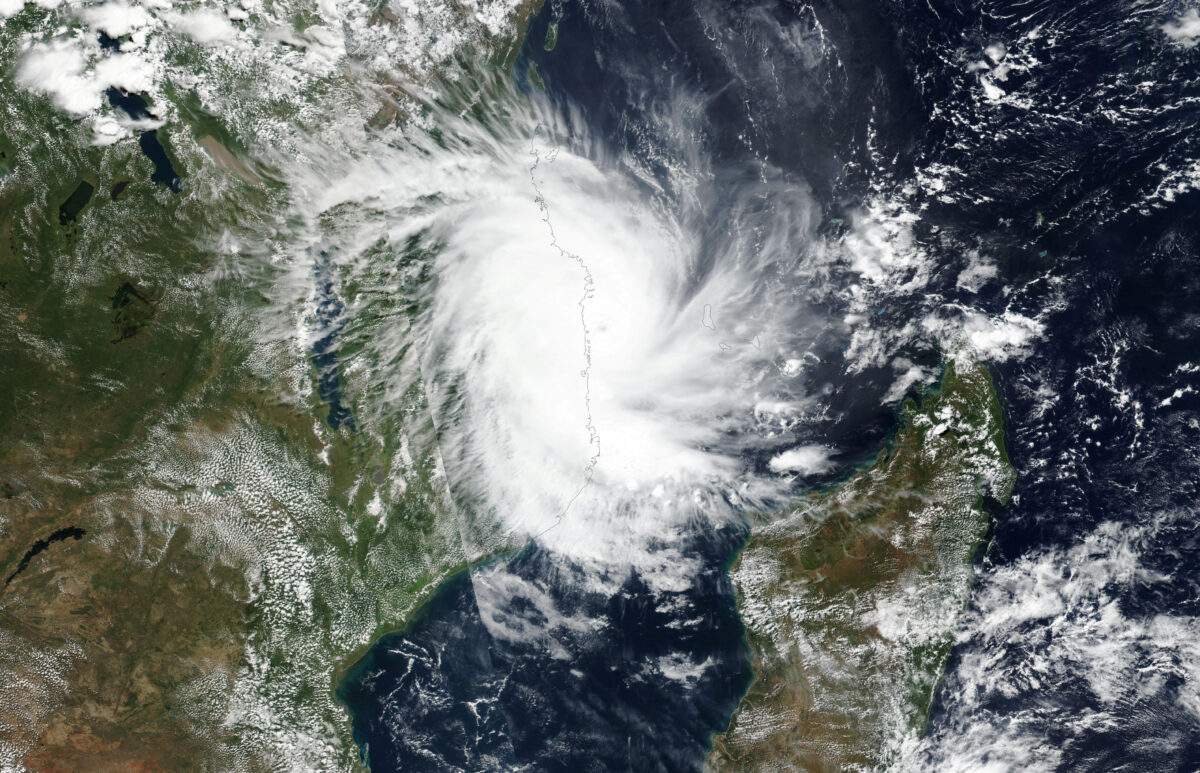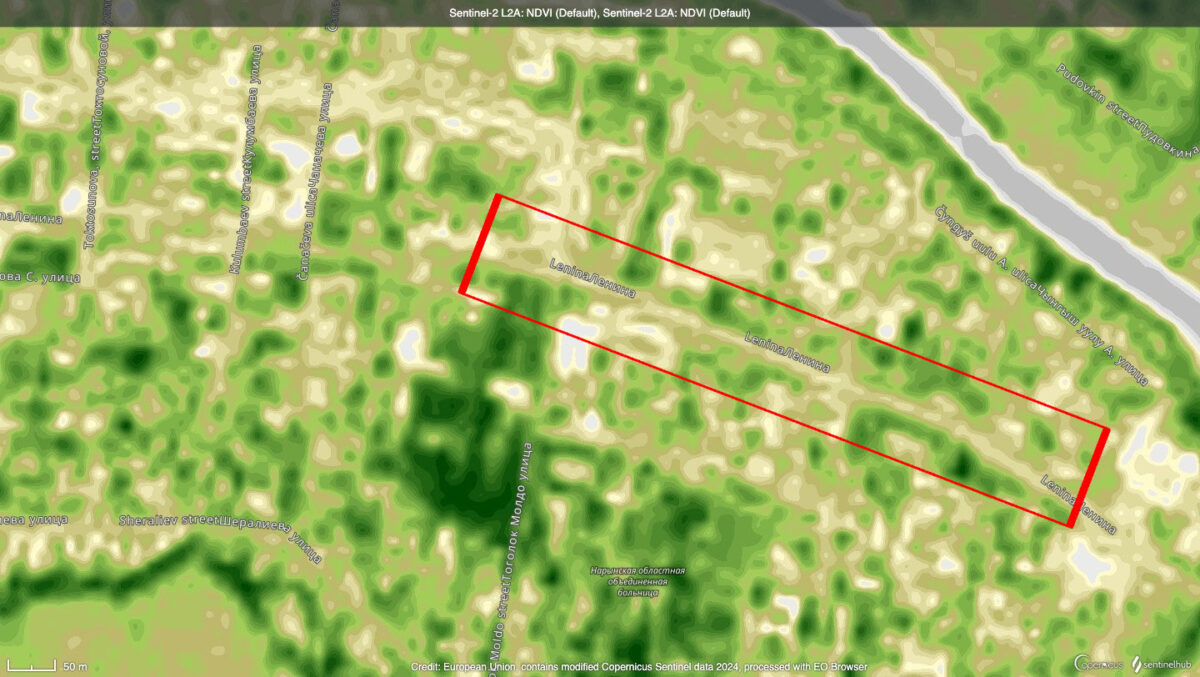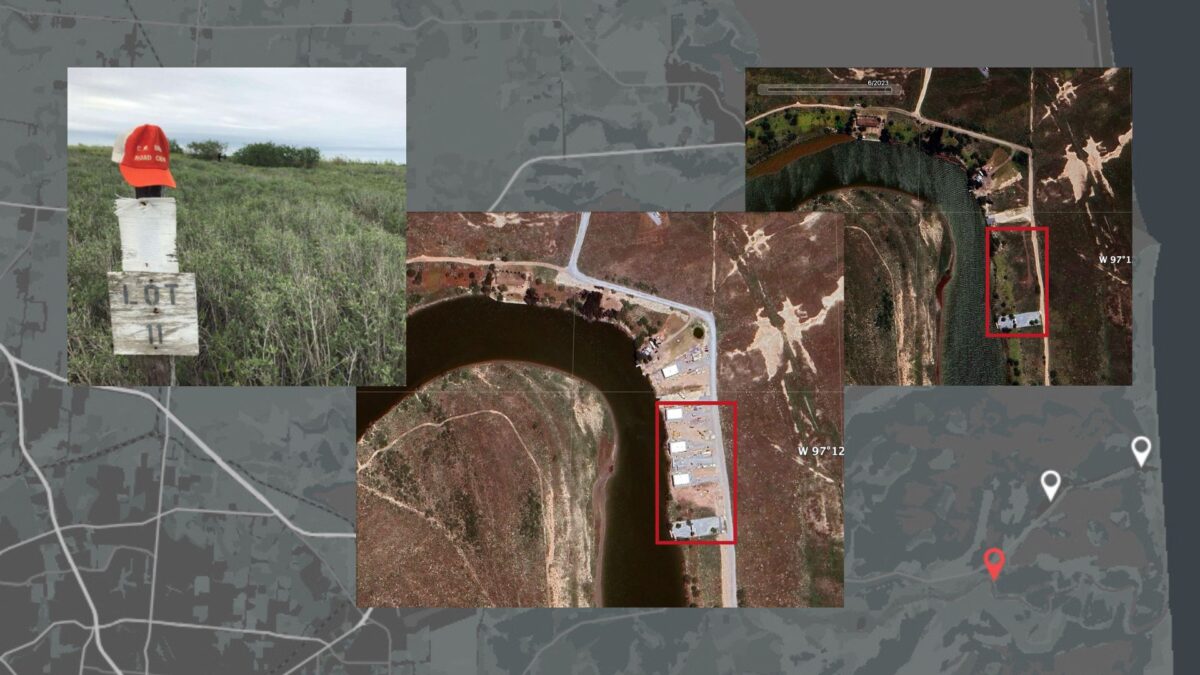Troubled Waters: Documenting Pollution of Iraq’s Shatt Al-Arab River
This report was written in collaboration with Maha Yassin (@mahaalGhareeb) from Basra, a junior researcher at Clingendael’s Planetary Security Initiative. Her research and input was provided in a personal capacity; this investigation does not necessarily represent the opinion of her employer.
When the Tigris and the Euphrates Rivers meet in southern Iraq, they take on a new name. They become the Shatt al-Arab, the River of Arabs, a 200 kilometre long estuary which crosses Basra Governorate before emptying into the Persian Gulf. The Shatt al-Arab is the lifeline of southern Iraq; it irrigates agricultural land and is a major transport artery.
It is also in ill health.
So when images appeared on social media this June showing oil spills on the Shatt al-Arab in Basra, Iraqis immediately responded, voicing concern about a public health crisis.
Or rather, yet another public health crisis. For decades, the Shatt al-Arab has suffered from serious pollution. By 2018, fresh water was so scarce that the people of Basra faced an environmental catastrophe. Over 110,000 people became ill from polluted water sources, prompting mass demonstrations across the region.
Promises by national and regional governments to improve the crumbling infrastructure and stem pollution came and went. A survey on human security carried out by PAX, a Dutch peace organisation, in 2019 showed that despite improvements over the previous year, residents of the Basra Governorate remained pessimistic about prospects for security: a staggering 30 percent of respondents reported having less access than before to basic services, including fresh water.
Recent incidents do not bode well for the future; water supplies continue to be polluted by oil spills and sewage. In recent years, Basra’s residents have become increasingly active online, documenting incidents using their cellphones and sharing on social media or with journalists who reported on it. Alongside more traditional media sources, this civic activism has become invaluable in visualising, thereby documenting, the toxic legacy of structural neglect to public services and water infrastructure.
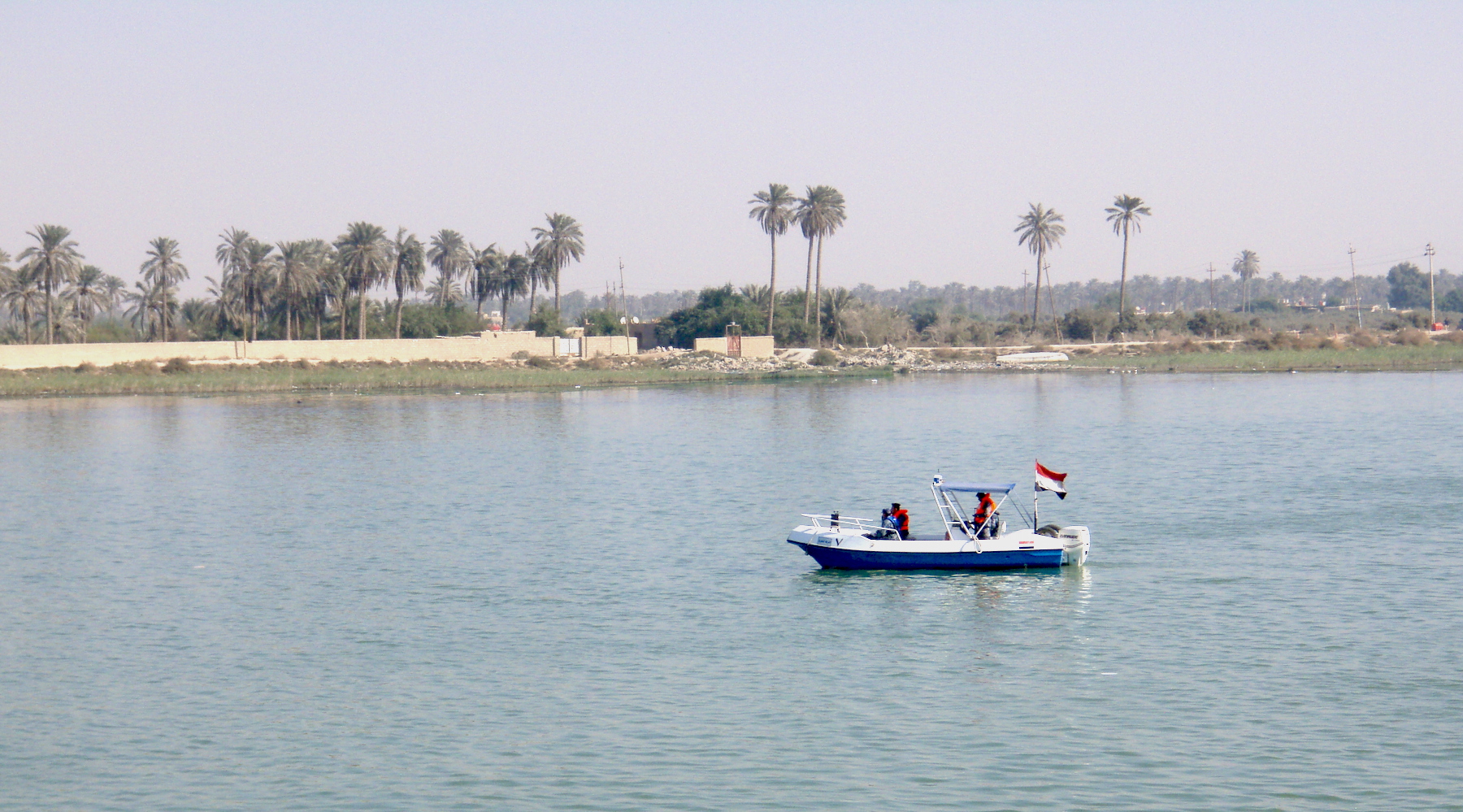
Iraqi patrol boat, Shatt Al-Arab, 2010. Photo CC-BY-2.0: Ken & Nyetta / Wikimedia Commons. Some rights reserved
Back to the future
This environmental crisis has been in the making for decades, compounded by past conflicts and problems with pollution.
Famously, Iraq is blessed with the world’s fifth-largest oil reserves. However, that may been more of a curse for the country’s waterways. A 1985 research paper estimated that 200,000 tonnes of oil residue from were discharged into the Persian Gulf every year. As one research paper noted, “sewage discharge and urban run-off may be considered as the most significant sources of oil entering the Shatt al-Arab.”
Those words were written when war raged with neighbouring Iran. The 1980-1988 conflict marked the start of a series of calamities for the Shatt al-Arab.
Firstly, Iraqi leader Saddam Hussein drained the nearby marshes as punishment to local tribes whom he accused of aiding the enemy. This sensitive ecological habitat has yet to fully recover.
As war encroached deeper into Iraq, ships were sunk beneath the river’s surface. Shelling destroyed thousands of the date palms which were once the hallmark of Basra’s riverbanks and are an important cash crop for local people. According to a May 2020 research paper about the period, ‘soil fertility was depleted, irrigation infrastructure was neglected or destroyed, and cropland suffered from salinisation’.
Iraq’s 1991 invasion of Kuwait and subsequent international response also resulted in targeting some key infrastructure in and around Basra, including power stations necessary for sewage and water filtration.
Then came the US invasion of Iraq in 2003, which led to the near-complete collapse of the Iraqi governance, followed by a bloody insurgency in 2006. In the aftermath, there was little interest or investment in timely recovery programmes for damaged habitats, contributing to worsening conditions for environmental regulation and its enforcement.
Unable to compete with cheap foreign produce, local farmers suffered. In many cases, their date palms never recovered.
The oil industry was luckier. Thanks to foreign investment, it was even able to boost its production after the war. Although some foreign oil companies included environmental concerns in their oil exploitation, the environment remained under threat. Corruption among government officials reportedly worsened the lack of proper investment in Basra’s wider public sector and environmental infrastructure, including water and sanitation services, where communities often see little from the billions of dollars of oil revenues.
But they do receive trickle-down pollution from upstream.
Many of Iraq’s largest industrial facilities are located along the Tigris and Euphrates, before they combine to form the Shatt al Arab river. They include power stations, water treatment plants, and sewage stations, paper mills, international airports such as that in Basra, and many other oil-industry related facilities. This runoff has been found to contribute to pollution in the Shatt al-Arab.
Another study published in Nature Research in 2020 on pollution in the river found elevated levels of heavy metal contamination such as nickel, chromium, manganese, molybdenum, copper, lead and zinc with sources coming from fertilisers and sewage sludge, metal welding workshops, and the oil industry. Locals continue to protest against the oil industry, including its facilities used to inject water into oil wells.
The latter is also facing more scrutiny from Iraqi researchers, who noted in 2019 that despite the economic development it brought, the oil and gas industry contributed to air, land and water pollution. “Moreover, it has caused major social damage due to the diseases, occupational accidents, job injuries and depletion of non-renewable resources and energy for present and future generations”, continued the researchers. This July, the impact of air pollution on local communities was covered the New York Times, alongside other international media.
These are just some of the reasons why people in Basra took to the streets in mass protest in 2018. Remarkably, at that time, these problems had already been known to the government for over a decade. Reports from 2005 and 2009 by the Iraqi Ministry of the Environment acknowledged discharged wastewater from Basra city into the river, as well as ‘industrial, service, and agricultural water discharges’ from power stations, factories, and hospitals. A Ministry of Planning report from 2010 includes similar admissions, as did several others reviewed by Bellingcat.
A cocktail of hazardous pollutants has flowed into the Shatt al-Arab, making locals residents’ fight for environmental and social justice as urgent as it is grueling. But like observers of this crisis from afar, they now have something which previous generations do not — access to open source materials.
OSINT as a tool for environmental justice?
Social media platforms have long since become Iraqis’ primary source of receiving and sharing news, reflecting a wider mistrust towards news media since 2003. Reports indicate that a large number of Iraqi media outlets are owned by or affiliated to certain political parties, favouring certain sides in domestic political conflicts or other disputes where the interests of relevant actors are at stake. Thus, these partisan media outlets generally have not paid much attention to ecological issues such as water pollution or the impact of climate change and conflict on the environment.
To fill this gap, Iraqis have launched several Facebook pages which are used to document different environmental incidents, raising awareness and promoting local cleaning or greening campaigns. Their concern and their resourcefulness in documenting this environmental damage can easily be seen by searching Facebook, Twitter, and YouTube for Arabic phrases such as ‘ShattalArab’ [شط العرب], ‘pollution’ [تلوث], ‘shipwrecks’ [حطام سفن، سكراب سفن، غوارق], ‘sewage’ [مجاري، مياه مجاري، مياه اسنة] and ‘oil’ [نفط].
Importantly, the aforementioned 2009 Ministry of the Environment report is not the only indication that Iraqi authorities have known of these environmental problems for many years. In fact, several freely available documents from government ministries and international organisations alike suggest the same, further giving credence to protesters’ accusations of inaction.
Oil spills, from far above
Some of Iraq’s vast oil wealth makes it above ground in the form of spills that pollute the country’s largest rivers.
The 2009 report from the Ministry of Environment report outlines how oil impacts biodiversity through polluting surface water and beaches, in turn affecting aquatic life, birds and animals, while also damaging agricultural lands and orchards. There are also consequences for human health, too: the oil clogs filters at water purification stations, and through soil pollution it can enter the food chain. The image below shows examples of oil spills and pollution on the Shatt al-Arab.
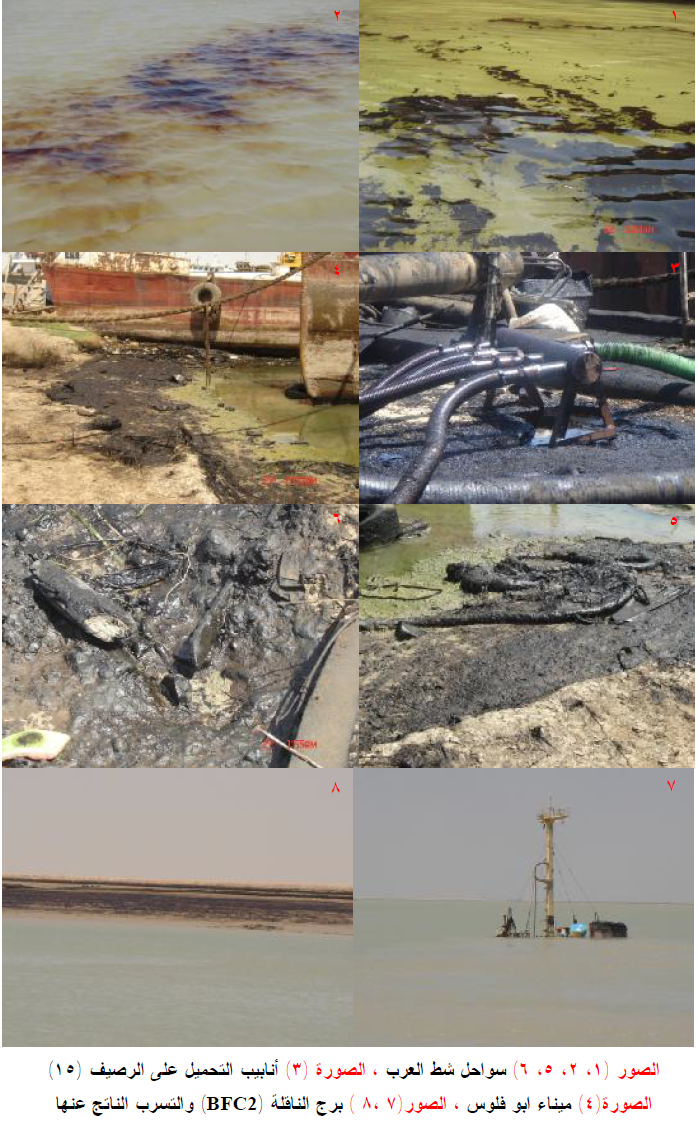
Various sources of oil pollution documented by Iraq’s Ministry of Environment in 2009
In August 2015, a report was broadcast on Fallujah Channel, a local TV station, showing an oil spill on the river and featuring nearby residents’ complaints about oil and solid waste. Using LANDSAT-8 imagery through Sentinel Hub, Bellingcat identified black patterns on the water’s surface that can be traced back along the river to at least the Al Hartha Power Station in the North-East of Basra Governorate. However, this does not conclusively prove that the power station was the source.
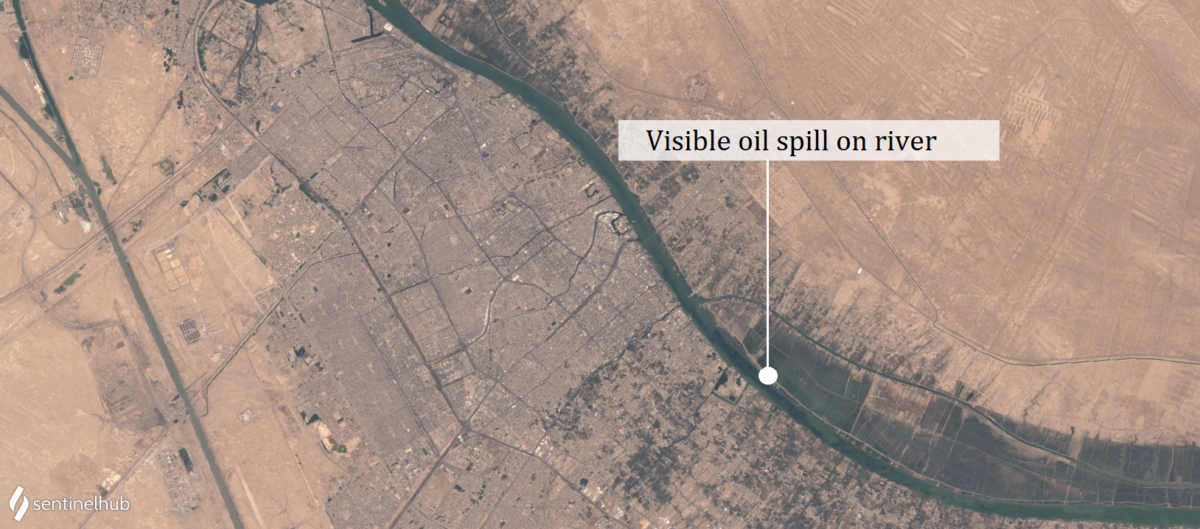
Oil spill on the Shatt al-Arab, August 19, 2015 visible on LANDSAT 8, NASA via Sentinel Hub
However, in 2016, more reports surfaced about an oil spill from another powerplant in the region, namely the Najibyah Power Plant located in the north of Basra City. This item on January 26, 2016 from the local channel Al Fayhaa TV, shows spills south of the power plant. These spills were also reported on February 2, 2016 by Al Arabiya, a regional media outlet. According to the chairman of the province’s electricity committee, the spill was caused by heavy rains that led to a storage tank to overflow and spill oil into the river.
A further oil spill was observed in the same location in March 2017, featuring in a TV report on NRT Arabic. Here oil waste or other pollutants came from Shatt al-Turk canal south of the facility.
Bellingcat was able to geolocate both the 2016 and 2017 videos to the vicinity of the Najibyah powerplant. Both TV items were made by Ahmad Abdul Samad, an Iraqi journalist who regularly reported on pollution until he was murdered with his cameraman in Basra in January 2020. Ahmad Abdul Samad had actively used social media to report on the Basra water crisis of 2018. In several posts, the journalist can be seen condemning the poor measures taken against pollution and the neglect shown towards Basra residents’ demands for clean and accessible water.
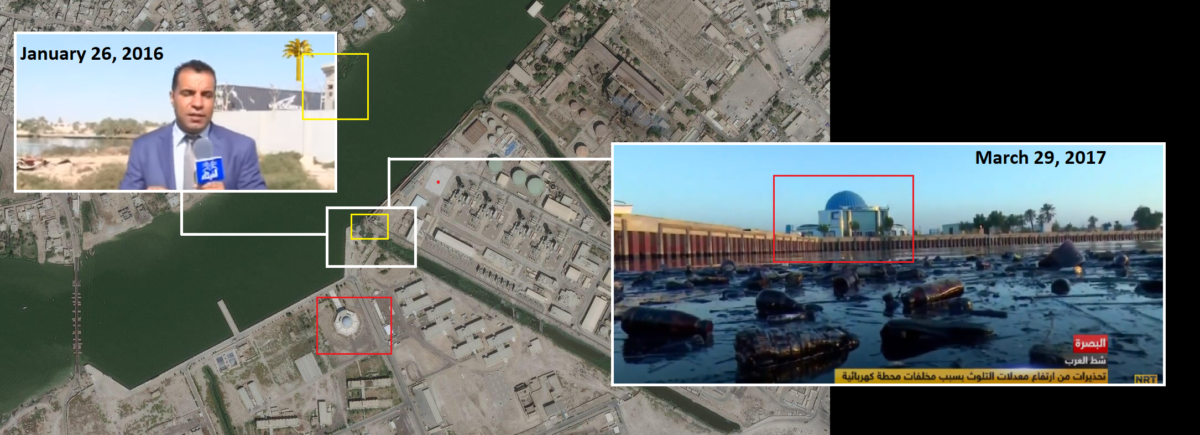
Geo-located footage from a TV report showing oil spills from the power station into the river
The water crisis of 2018 bought the question of oil spills to greater prominence. The 2019 Human Rights Watch report ‘Basra is Thirsty’, addresses one oil spill in the Shatt al-Arab which dozens of kilometres long. Imagery from Planet Labs, accessible via Planet Explorer (via Human Rights Watch) shows the large oil spill flowing down the river for at least one week from June 15. Footage posted on Youtube by Al Mirbad media on July 22, 2018 also seems to show the oil spill on the surface of the Shatt al-Arab flowing through the centre of Basra City.
More footage of possible oil pollution was broadcast on August 29, 2018 by the Al Rafidain TV network. Bellingcat examined Sentinel-2 imagery from that date to establish whether oil spills were visible on the river, but couldn’t find any imagery of oil on the water. This suggests either that Al Rafidain’s footage actually showed the aforementioned spill from June-July, or that the discolouration was due to something else — potentially another source of pollution or a natural cause.
The sources of these reported spills seem to originate near the various power plants and factories along the river upstream in the city or above the city, such as the aforementioned Najibyah and Al Hartha power plants or the Ben Omar oil facility and its adjacent paper mills.
But the Shatt al-Arab is not only affected by local sources of pollution — after all, most of Iraq’s watershed drains into this estuary.
For example, on January 31, 2019, footage appeared on Twitter showing huge floodwaters coming from neighbouring Iran, bringing with them pollution and crude oil. While the user suggests that the location is Ahvaz, in southern Iran, Bellingcat believes that it is more likely to be the Al-Fakkah oilfields in the Maysan Governorate, on the Iran-Iraq border. More details on how this conclusion was reached can be found in the Twitter thread below (which includes a typo, the correct date should be January 2019):
Early January 2020, a video was posted online showing oil tainted water flooding lands, allegedly somehwere in southern #Iraq. What could be potential source? Here's a brief environmental #OSINT exploration on a potential location 1/X https://t.co/d2zDoV1pjz
— Wim Zwijnenburg (@wammezz) October 16, 2020
This location is still relatively far from the River Tigris, to which it has no direct flow. Therefore, it is more likely that this crude oil spill ended up in the Hawizeh Marshes (a full overview of the flow of these rivers into the Shatt al-Arab can be found via the Inventory of Shared Water Resources in West Asia).
Run-off from refineries, oilfields and power plants is a widespread problem across Iraq. For example, on June 11, oil runoff caught fire near the town of Diwaniyah, capital of the Al-Qadisiyyah Governorate in central Iraq. A Facebook post from Yalla, an independent youth-focused news website, showed the extent of the blaze, to which local residents attributed a rise in health problems.
Severe pollution by a power station in Diwaniyah, southern #Iraq resulted in a fire of oil waste on June 11, 2020 and complaints of nearby residents over health problems, and an example of Iraq's crumbling energy infrastruture. https://t.co/UEm1gXbKQa Via @Yalla_EN pic.twitter.com/5btGnxT1JD
— Wim Zwijnenburg (@wammezz) June 12, 2020
Similar stories abound. On September 17, the Iraqi civil society initiative Humat Dijlah reported another spillage of oil waste in the Tigris River, emanating from the Al Dora power plant in southern Baghdad, the Iraqi capital.
Another spillage of oil waste reported on September 17, 2020, in the Tigris river coming from the Al Dora Power Station in southern Baghdad via @hdijlah1 adding to ongoing concerns over water #pollution in #Iraq https://t.co/gBjhSR24WG pic.twitter.com/rmkpXHKJhP
— Wim Zwijnenburg (@wammezz) September 27, 2020
But open source research also points to another, unseen source of pollution of the Shatt al-Arab — this time, from below the water’s surface.
Shipwrecks, far below
The heavy fighting of the Iran-Iraq War littered the Shatt al-Arab with marine wrecks. From oil tankers to navy vessels, freight ships to fishing boats, they continue to pollute the environment despite attempts over past decades to remove them from the riverbed. In 1989, a year after the ceasefire which ended the war, the the Journal of Commerce reported that 78 wrecks had been cleared.
Shortly after the US invasion in 2003, a UNEP report on the state of the Iraqi environment stated that there are approximately 260 wrecks in the Shatt al Arab, and warning that they are “carrying hazardous cargo including chemicals, crude and refined oil, bunker oil, battery acids, asbestos, other chemicals, short-range missiles and unexploded ordnance.” and funding was put towards removal of those wrecks. This was followed by a UNDP report from 2004, that found hundreds of vessels in and around Basra’s rivers. Sadly the original is not available online, and those reporting on the report draw the content from this 2005 “Warfare: Iraq’s Toxic Shipwrecks’ study in Environmental Health Perspectives, that also provides more insights on the nature of pollution in the river and the Persian Gulf from leaking oil.
In 2005, some online users even took the effort to make an online Google Sight Seeing tour of those shipwrecks visible on satellite imagery, which are today still rusting away, either barely floating or capsized, a dark memory of past wars.
A list of priority wrecks was found in a 2012 report by the Iraqi Ministry of Transport on the development of the Um Qasr harbour in south, noting the many shipwrecks filled with fuel and unexploded ordinance (UXO):
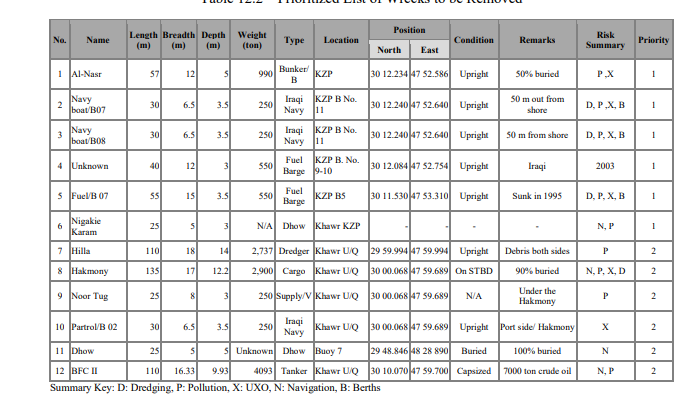
Overview of shipwrecks containing toxic and chemical substances, published in the MoT of Iraq report, June 2012
Repeated concerns have been voiced in the past by local authorities over the environmental risks of many of these ships, with hundreds of tonnes of crude oil still on board. Another article published in 2016 by researchers of University of Basra provides a longer list with 34 wrecks still at the bottom of the river.
In June 2020, a publication by Iraqi researchers using a sonar radar in a small sub to map shipwrecks in the Shatt al-Arab and identified over two dozen signatures, with almost a dozen confirmed wrecks of ships in the river next to and south of Basra City.
A substantial number of wrecks have now been cleared, yet incidents from this June and July demonstrate how leaking shipwrecks can still contribute to polluted surface water. As noted in Iraq’s first contribution to the Convention of Biodiversity, pollution from leaking shipwrecks can be a direct threat to marine life in these areas as well, and reiterated this message in their latest contribution to the CBD.
On June 15, 2020, Al Rafidain TV alerted the public to another oil spill, due to submerged underwater objects:
بقعة نفطية في مياه شط العرب قرب جسر التنومة تتسبب في توقف ضخ مياه الإسالة إلى مناطق واسعة من #البصرة
ـــــــــــــ#العراق | #قناة_الرافدين pic.twitter.com/BfupriiB3M— قناة الرافدين (@alrafidain_tv) June 15, 2020
Geolocation of the source put the reported spill north of the New Tanuma bridge in Basra City.
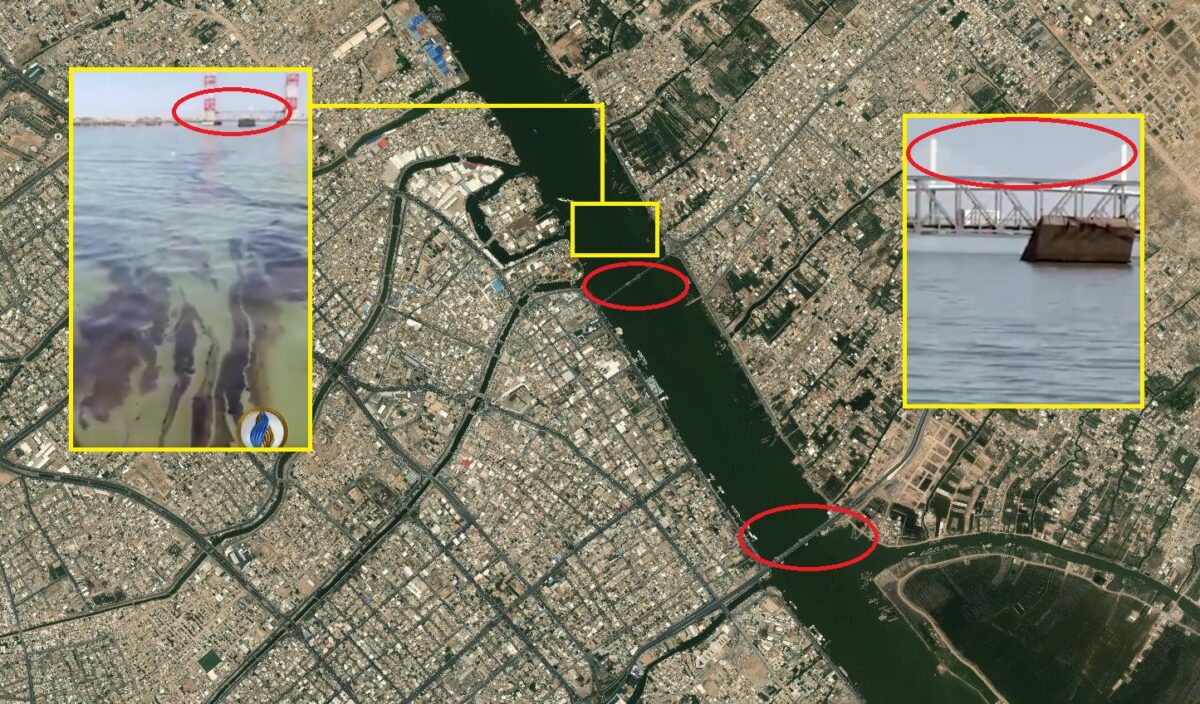
Geo-location of the June 14, 2020 oil spill, video images still via Twitter
According to one Twitter user, the spills on the water resulted in the shutdown of water purification north of the spill site:
ضمن مسلسل معاناة أهالي #البصرة جنوبي #العراق، انقطاع الماء عن خمسة مناطق في المحافظة؛ بسبب وجود بقعة زيتية بالقرب من ممصات مضخات السحب الواطئ في "شط العرب".
🔴🟡 للاشتراك في قناتنا على تليغرام:https://t.co/0BXAwaaPX8 pic.twitter.com/FHrNjGzdXF
— وكالة أنباء العراق الدولية – واعد (@wa3ediq) June 15, 2020
Confirmation of this spill came from local media source Iraq Akhbar, which reported that a sunken pontoon was the source of the spill. With the help of Sentinel-2 imagery, we can also see discolouration on the surface water on June 14, which could indicate processed oil such as benzine. However, it could also be specular reflection of sunlight on the waves.
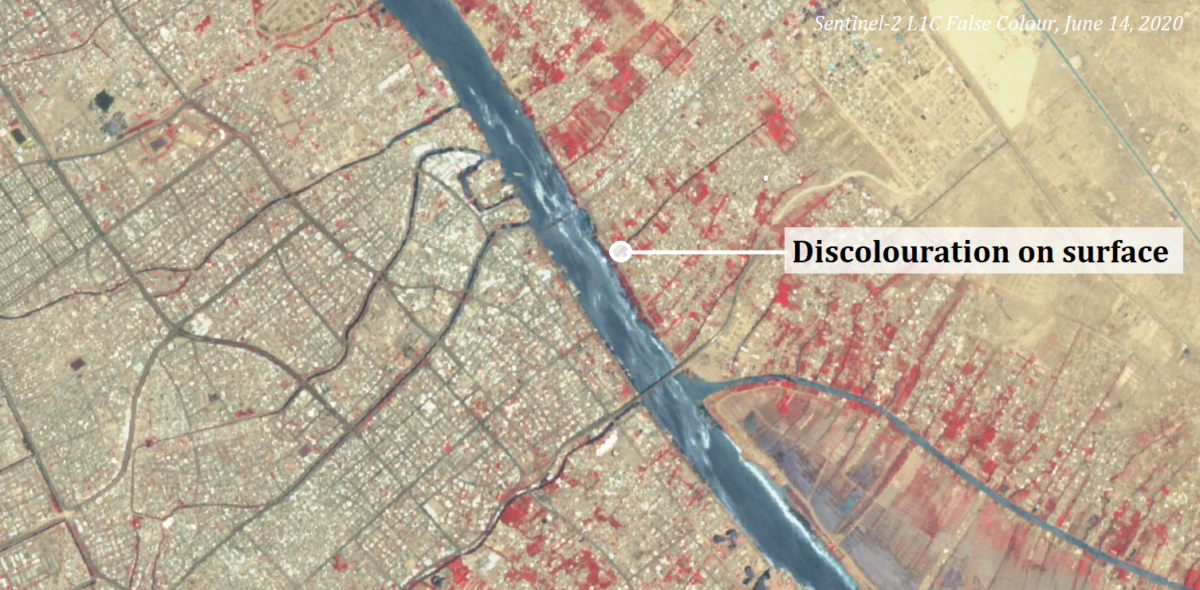
Sentinel-2 L1C, Colour Infrared Index, June 14, 2020
Bellingcat requested high-resolution imagery from European Space Imaging (50cm resolution from World-View-2, courtesy of MAXAR) for the area, dated June 16, 2020. The general overview of this area on satellite imagery clearly shows again the specular reflection of sunlight on the water, also known as sun glint.
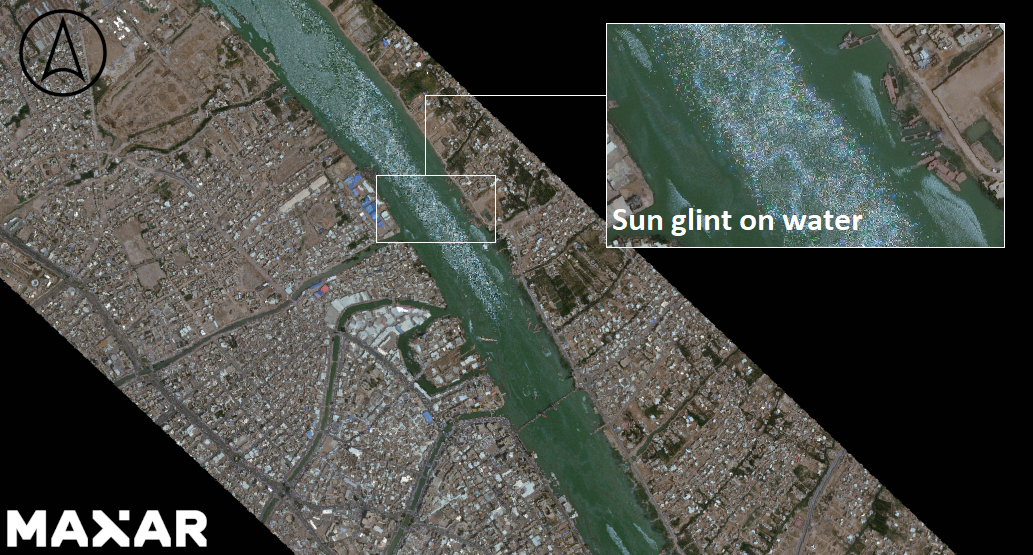
MAXAR/European Space Imaging, June 16, 2020
The image of the area shows the sunken pontoon and oil spills directly around it and some sun glint:
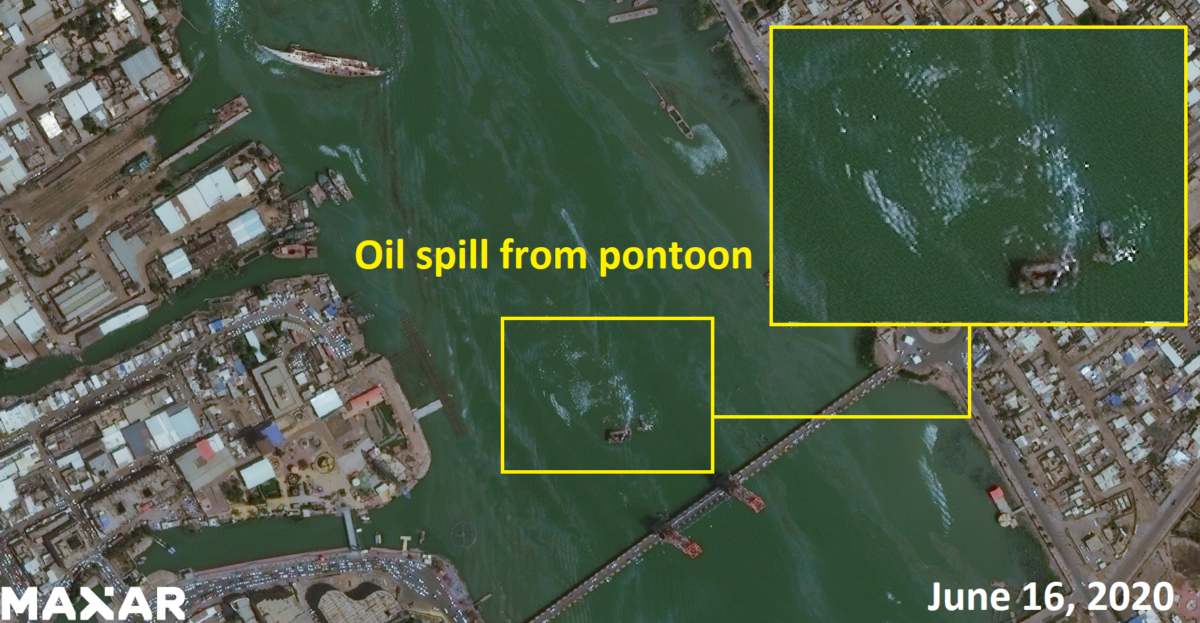
MAXAR, June 16, 2020, oil spill from leaking pontoon
Apart from the spill directly near the pontoon, there also appears to be other dark substances in the water. These could either be spills, algae bloom or other unknown substances. Any vegetation should be displayed in red when using a near-infrared spectrum. But this cannot be seen in the image below (or when using open-source medium resolution NIR from Sentinel-2 via Sentinel hub here), which rules out algal bloom:
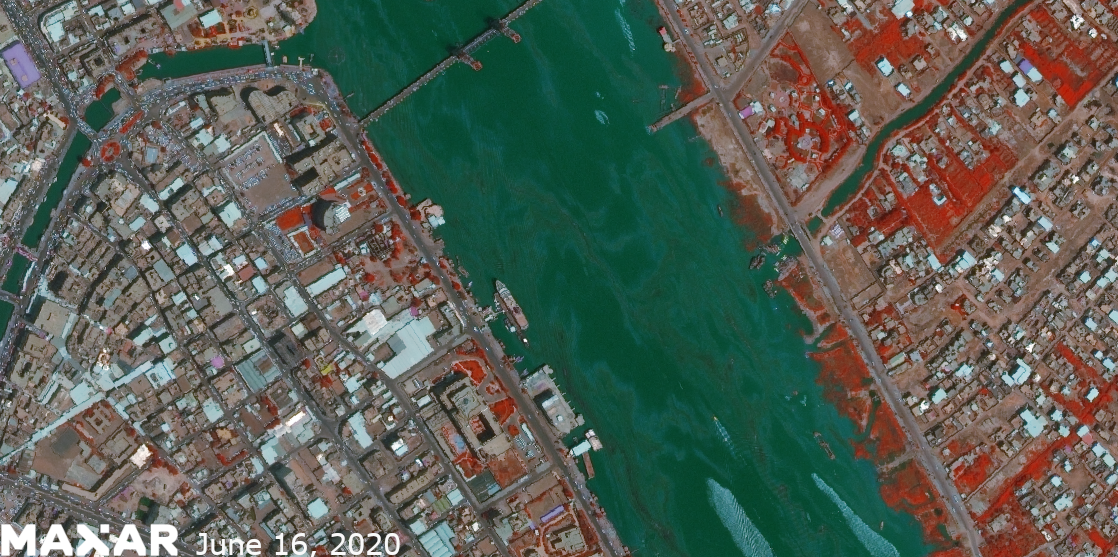
MAXAR, June 16, 2020, Near Infrared Image, Shatt al-Arab
Bellingcat shared this imagery with the anonymous Twitter user and OSINT specialist @obretix, who indicated that adjusting some of the histograms’ colours in Arc/QGIS could help clarify the patterns on the waters. Thanks to this technique, the stretched colour image below shows the telltale signs of a spill, which does seem to indicate that the dark matter is likely oil, and seems to spread quite wide over the river.
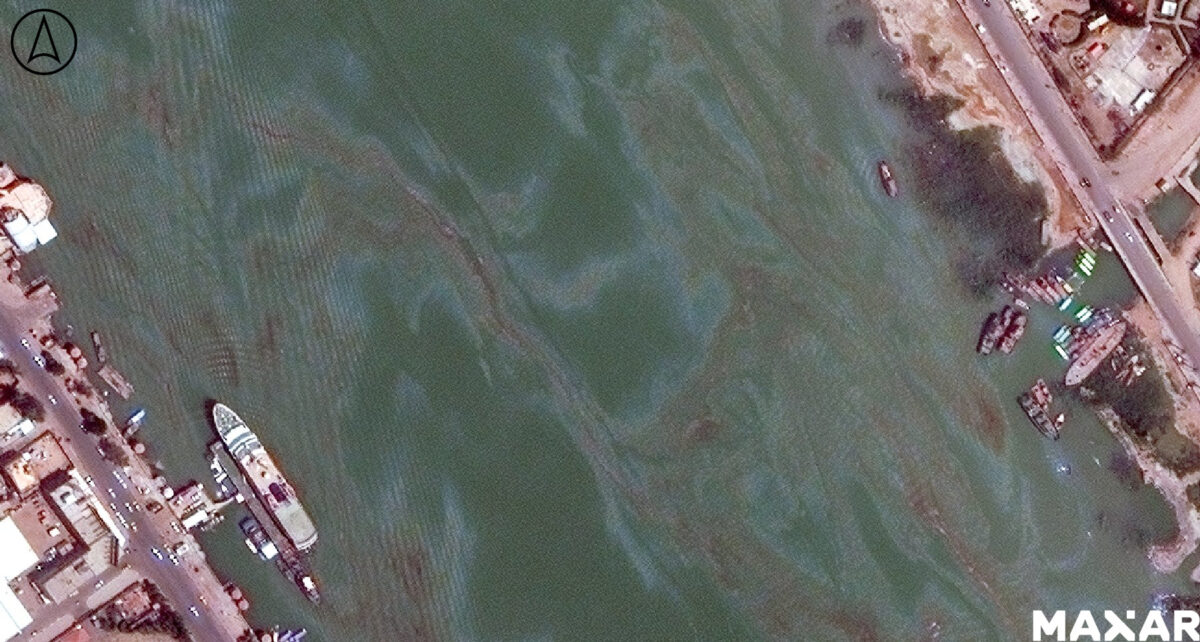
MAXAR, June 16, 2020, Oil spill on Shatt al-Arab, colour edited by @obretix
Could this all be oil? The following video posted online by Humat Dijlah shows the pontoon and oil spills, indicating both heavy dark oil and processed oil (with more vibrant colours) on the water:
تصرف خبيث من صاحب الشركة او الدوبة بتفريغ النفط الاسود المشبع بالكيمياويات مباشرة في شط العرب
المكان: قرب جسر التنومة #البصرةنطالب الجهات المعنية بمتابعة وايقاف هذه الانتهاكات البيئية بحق اهالي البصرة وشط العرب#حماة_دجلة pic.twitter.com/O02v9Qpigj
— حماة دجلة | Humat Dijlah (@hdijlah1) July 27, 2020
However, the spills didn’t end there. Further oil spills can be seen on the Shatt al-Arab using Planet Labs and Senitel-2 imagery. These were confirmed as such by members of Humat Dijlah. The direct source of those spills are unknown however, but considering that they resemble processed oil, the dumping of oil waste water from a ship passing through is a likely contender.
Not sure what is happening in #Basra seems still ongoing #oil spills on the Shat al Arab on July 14-15, visible with both @planetlabs and @sentinel_hub pic.twitter.com/bWiG92oBgG
— Wim Zwijnenburg (@wammezz) July 24, 2020
Sewage, all around
A further source of major pollution in the Shatt al-Arab is the dumping of sewage and solid waste.
Successive Iraqi governments have been tasked with addressing the issue, but to little avail. This AP report from 2000, for instance, showing the direct discharge of untreated sewage into the Tigris and Shatt al-Arab outside Basra. Prior to the 2018 water crisis, references to these problems surfaced in practically every relevant government report, including the aforementioned The National Environmental Strategy and Action Plan for Iraq, the joint analysis by UN agencies post-2003, Iraqi submissions on the state of the environment and biodiversity to the Convention on Biological Diversity (CBD), the latest being in 2018, to UN Environment post-conflict analysis and UNICEF warnings.
Local NGOs such as Save the Tigris and international networks alike have been raising concerns prior to Basra’s water crisis, most notably on upstream pollution of the Tigris in Baghdad and wider environmental concerns.
A 2013 analysis on Iraq’s water and sewage sector conducted by consultants for Japanese businesses indicated that Iraq produces 580 million cubic liters of waste water on an annual basis, noting that most of its waste water treatment facilities are in ‘various stages of disrepair’. The report provides a bleak reading into a failing government unable to establish a coherent strategy and assign proper budgets to fix its waste water infrastructure. The aforementioned HRW report on Basra’s water crisis, released five years later, suggests that little had changed in subsequent years.
Thus the dumping of sewage in local rivers is a known phenomenon; a clear example of this practice surfaced in July 2020 in Al-Muthanna, a province North-West of Basra. In this video, geolocated and verified by a local Iraqi environmentalist in the town of Rumaythah, its is claimed raw sewage is dumped into a local creek, geo-located in the image below the Tweet.
#رصد
تتكرر هذه المشكلة الخطيرة في عدد من المحافظات العراقية، وهذه المرة في محافظة #المثنى بشكل مأساوي.
الفيديو ادناه يصف الوضع المائي الخطير في المثنى.
نطالب الجهات المعنية في المحافظة بتقصي الامر ومعالجته فوراً.
الرصد بتاريخ اليوم ٢٢/٧/٢٠٢٠
##حماة_دجلة pic.twitter.com/j0DgiuyP3o— حماة دجلة | Humat Dijlah (@hdijlah1) July 22, 2020
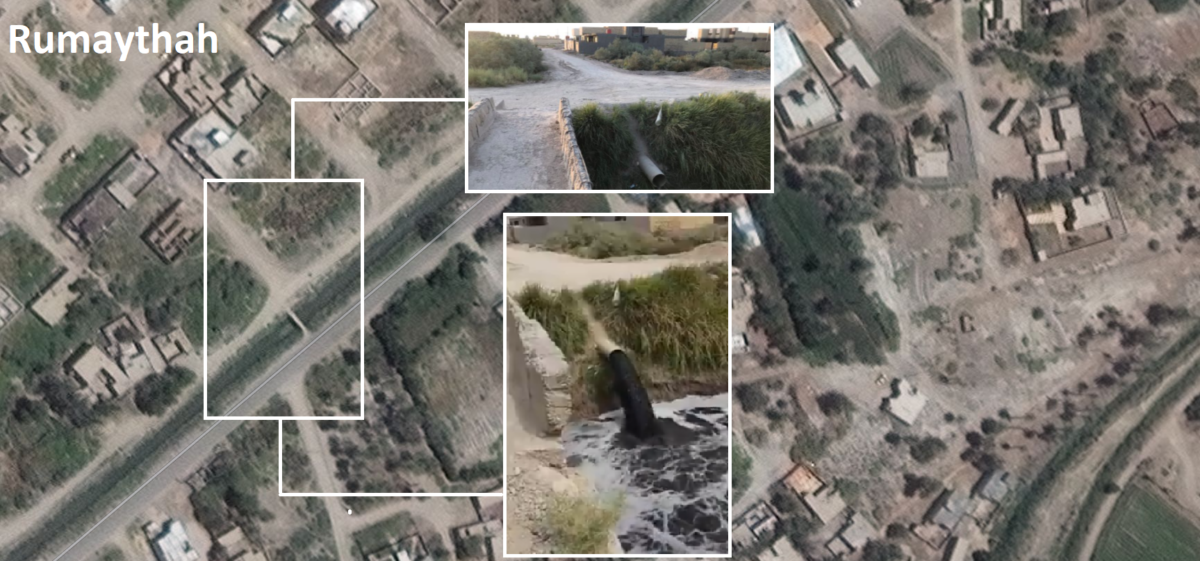
Geo-location of sewage dump in Rumaythah, screenshots from videostill posted on Twitter by @hdijlah1 and @ali731981
Further problems with Basra’s water infrastructure were recently reported by the Basra Electronic Newspaper in a Facebook post on July 27, 2020 when a road collapsed, raising concerns among civilians over the condition of a nearby wastewater canal, which leads from a large sewage water treatment facility. The canal is meant to discharge wastewater into the Shatt al-Basra, an artificial river dug in the late 1970s in order to divert waste water from agriculture directly into the sea, instead of flowing into the Shatt al-Arab. Concerns voiced by local residents suggested ongoing frustration with poorly maintained water infrastructure.
Judging by local media and social media reports, problems with wastewater spillage have continued ever since. According to Humat Dijlah, locals continue to report on wastewater spillages affecting nearby residential areas:
هاي المشاهد مو من بحيرة الحبانية
ولا بحيرة ساوا ولا الاهوار العراقيةهذا كسر في الخط الرئيسي لانبوب الصرف الصحي، يفيض الشارع على مسافة 3 كيلومتر
الرصد من #حماة_دجلة_البصرة
المكان: البصرة – ابو الخصيب
الوقت: الاحد 20 ايلول 2020 #شبكة_الرصد_البيئي pic.twitter.com/jCbEKkUv0Z— حماة دجلة | Humat Dijlah (@hdijlah1) September 21, 2020
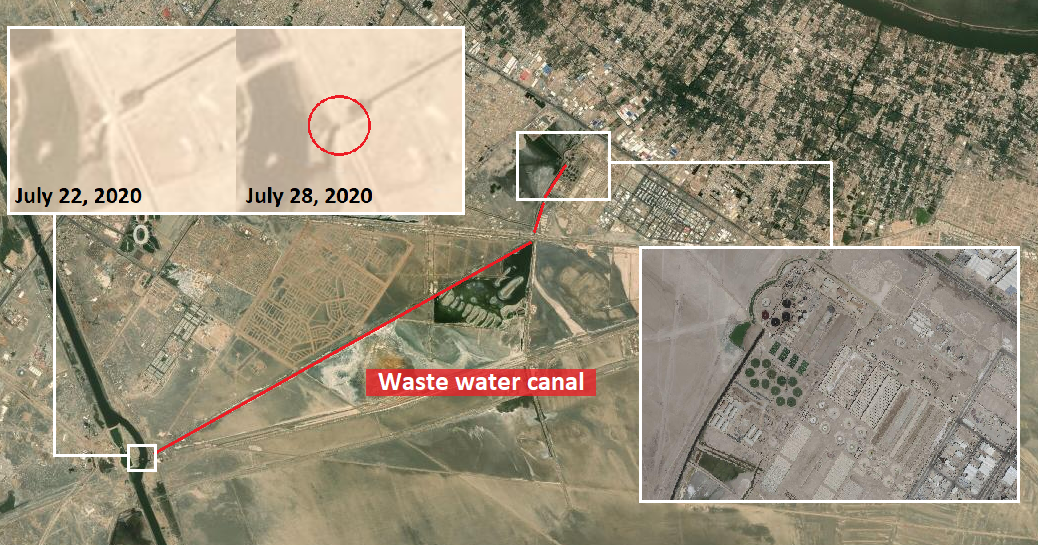
Waste water pipeline spill south-west of Basra, imagery via Planet Labs (left) and ESRI (right)
The flooded lands along the canal and pipelines leading from the sewage water treatment facility can be easily seen on this timelapse using a Sentinel-2 satellite imagery between July-September 2020:
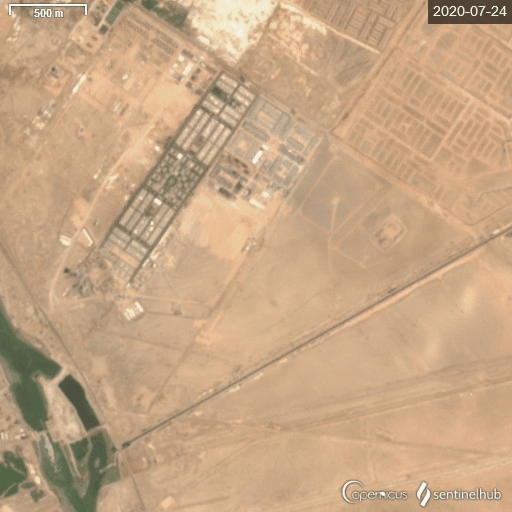
Sentinel-2 Timelapse. European Space Agency
These spillages appear to be affecting downtown Basra. In a post on Facebook from August 2019, one citizen complains about the smell at the opening of what is alleged to be a sewage pipeline discharging into the Shatt al-Arab in front of the city’s Central Bank building.
These examples go to demonstrate the ongoing problems with water infrastructure in Basra and the active role of concerned citizens and activists in monitoring the situation. In September 2020, a new visual tool was released by REACH on the water security situation in Iraq, including an online dashboard called WASHapp, with all the 240 known water treatment plants in Iraq and their current status. The screenshot below shows the status of all these facilities in Basra:
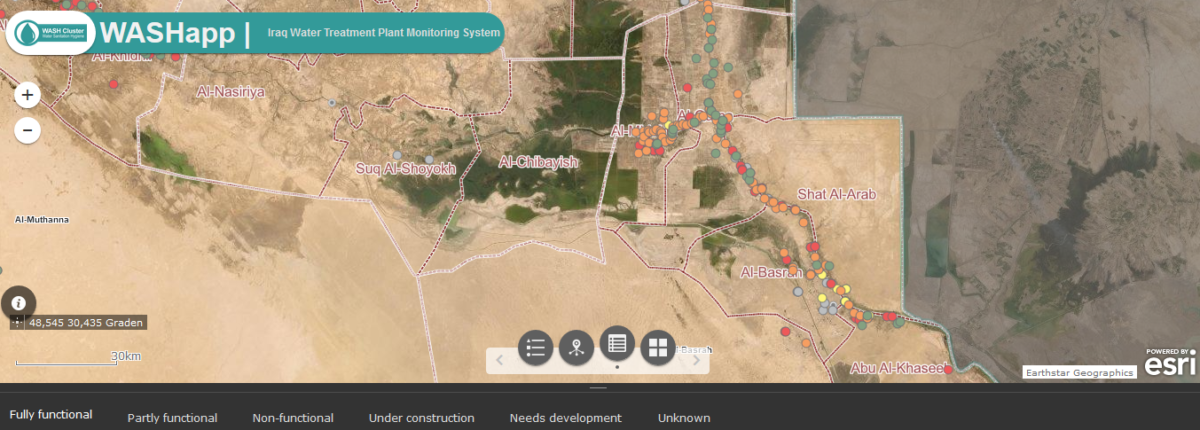
Screenshot of the WASHapp
The tool shows if a water treatment plant functional, how much water it is processing and what areas are contributing to the facility. This application adds to the growing list of monitoring tools based on remote sensing and visual identification using earth observation, combined with ground verification methods. Such efforts help strengthen accountability on promises given on improving environmental infrastructure and related public health concerns.
Despite efforts by local activists to clean up solid waste in and near the Shatt al-Arab on World Environment Day 2019, incidents continue to raise concerns. That year, the BBC aired a report on how local people took to social media to complain about ongoing waste and water issues; one such video was widely shared on Facebook.
Throughout this year, anonymous Twitter users have continued to report on solid waste problems and failures of sewage treatment in Basra’s Hussein neighbourhood, again indicating the neglect of waste treatment facilities and wider infrastructure problems.
Furthermore, in summer 2020, local media outlet Al Mirbad aired a news report about sewage leakages and lack of waste collection, showing sewage flooding the streets of the Al-Mishraq neighbourhood in Basra. These scenes attest to the fact that more intensive cleanup efforts may be required, especially with the rapid rise of Covid-19 cases in the country.
The fight continues
Two years since mass protests, the beleaguered people of Basra continue to wrestle with a public health crisis and to fight for a clean and unspoilt Shatt al-Arab. The examples above, whether oil spills, shipwrecks, or contaminated water, attest not only to the scale of their struggle, but to their resourcefulness in identifying concrete incidents of pollution.
There is not only a wealth of information online, but a wealth of tools which can be used to understand it. Geolocation, publicly available remote sensing data and satellite imagery help to piece together a picture which demonstrates the Iraqi state’s failure to seriously tackle the poor state of water infrastructure.
That picture might be a depressing one, but it can also inspire wider calls to take action for environmental protection. Iraqi citizens are already heeding that call online, out of concern for their livelihoods and even their lives. Tied to the security threats which have rocked the country for decades, issues of environmental degradation, pollution and climate change are no longer secondary problems for Iraqis. They are continuing to protest, demanding that the government improve public services and guarantee clean water for all — an even more urgent need during the COVID-19 pandemic.
